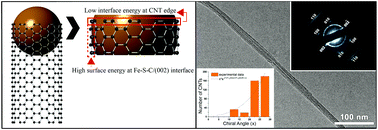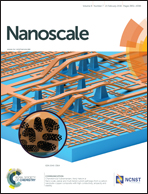Inherent predominance of high chiral angle metallic carbon nanotubes in continuous fibers grown from a molten catalyst†
Abstract
We present evidence that high temperature CVD growth of SWNTs under conditions of continuous spinning of macroscopic fibers leads to an inherent predominance of high chiral angle CNTs, peaking at the armchair end. Raman, UV-vis-NIR absorption, and photoluminescence spectroscopy measurements show the prevalence of metallic SWNTs. The complete chiral angle distribution is obtained by electron diffraction of over 390 CNTs. It is biased towards high chiral angles and peaks at the armchair end (30°), in good agreement with the established atomistic models for SWNT growth from a liquid catalyst. Based on the Fe–C–S constituent binary and ternary phase diagrams, thermodynamic calculations of phase compositions from fast cooling and experimental evidence of a post-synthesis catalyst, the proposed thermodynamic path of the catalyst is to form a solid FCC Fe core and a liquid Fe–S shell. S in the outer liquid shell first stabilizes the edge of the nascent CNT, but once a graphitic wall forms it is rejected due to the high interfacial energy of the Fe–C–S alloy.


 Please wait while we load your content...
Please wait while we load your content...